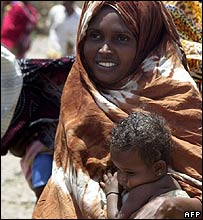Culturally-Competent Services for Maine's
Somali Refugee Population

http://unimaps.com/flags-africa/somalia-flag.gif

http://newsimg.bbc.co.uk/media/images
SOMALIA, 2005
( HIV/AIDS Cases: 44,000 / Population: 822,800 ) * 100,000 =
AIDS Rate of 5,348 cases per 100,000 people.
According to the federal CDC, Maine's Somali refugee population is an "immigrant group for whom states have little or no data" (14).
Somalia's HIV/AIDS rate in 2005 was 5,348 cases per 100,000 people, a figure that is slightly over 58 times Maine's cumulative AIDS rate of 92. Thus, if one out of every 20 Somalis are predicted to have HIV/AIDS and 1,000 refugees came to Lewiston a few years ago, then approximately 50 of these refugees were affected by HIV/AIDS. In the entire state, only 40 citizens were diagnosed with HIV in 2001, so the potentially negative implications of not having documented HIV/AIDS data for an estimated 50 infected immigrants are enormous. It would be wise for the Maine Bureau of Health to use a small portion of its overall state HIV/AIDS funding to institute a program in Lewiston targeted at providing culturally-competent services for the Somali refugee population residing there.
Without any ongoing education, testing, or opportunities to seek care, these Somali refugees may pose massive difficulties for long-term HIV/AIDS prevention and treatment in Maine.
